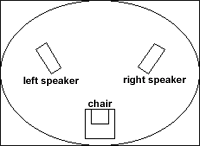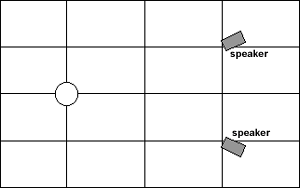![[SoundStage!]](../sslogo3.gif) Audio Hell Audio HellBack Issue Article |
November 2001 A Free Ride: Speaker Placement Part 1 I finally did it. I didn’t like it, but it’s done. All it cost me was a sore back and my day off. Was it worth it? You better believe it! So if I can do it, you can get out of your upholstered listening throne and do it too. What I’m whining about here is speaker placement. It’s one of those things that is not the favorite part of our obsession. The fun part was reading up on all those cool new designs, visiting your local dealers for listening and evaluation, then finally making the jump and taking a pair home. But once you have them there, what do you do with them? Your room certainly makes the top-ten list for most important component, yet is the one most ignored too. Many folks are limited by (how can I put this politely?) aesthetic constraints. There is one place that the speakers can go and not mess up the "look" of the entire room. You should be happy that the ugly things are allowed in the room at all, right? I don’t know how many cases I’ve seen of a well-designed sonic beauty brutally shoved against the wall or tucked into a corner. You might as well save your money, folks, or invest in a really good pair of headphones. Hmmm. Others simply plop them down, pull them out from the wall a little and call it good. I don’t think so. My room measures 24' 2" by 13' 8" with 8' ceilings. Before I began this venture, my speakers were pulled out about 66" from the front wall and 36 1/2" inches from the side walls. I’m not quite sure how they ended up there. I’d dabbled in speaker positioning, but I never really got serious about it. Somehow I knew that it would turn into one very large can of worms. In fact, it opened more than one. Consider this column can numero uno. There is more than one way to skin a cat, although I’m not sure who would want to. There’s also more than one approach to this speaker-placement thing. The more expensive ways involve the purchase of software packages or even costlier hardware for measurement and analysis. These are for a future column. For now I’ll focus on the free stuff, requiring no more than a calculator and a strong back. In my search, the big three methodologies that came up again and again were: the Cardas formula, the Audio Physic/Immedia method, and the Wilson Audio setup procedure, or WASP for short. In this column, I’ll focus on the first two. I’ll save the stinger for later. Before we begin working our way through these various methodologies, let me make a few things as clear as mud. First, I was fairly content with the sound of my speakers before I began moving things around. The soundstage was fairly wide and deep, the speakers imaged well, and I had decent bass. Secondly, the scientific method was not used here. Any resemblance to the scientific method is purely coincidental. My method, the "getupoffit method," works in the following way.
I also stuck with short-wall placement. Although there are those who are blessed with dedicated listening rooms who can make as big a mess as they want, I believe they are in the minority. This would definitely not work in my house without moving door locations, for instance. With that in mind, let's move on to the first of the formal methodologies. Roll over Fibonacci, tell George Cardas the news This method is based on perfection. The perfection I am talking about is mathematics. I flunked college algebra twice. It makes for a damn difficult argument convincing my wife how perfect I am. But let's forget about my limitations for a moment; we’re all reminded of ours much too often, aren’t we? In this method, George Cardas talks about the Golden Cuboid or perfectly proportioned listening room. This room measures 10' by 16' by 26'. Well, I guess most of our rooms would lean more toward the "brown" than the "golden." Without the Golden Room, we are left with the Golden Ratio to set up our speakers. According to Cardas, what we are trying to do is to limit the interaction of nodes in our room. Damn nodes, I thought the exterminator was just here last month. Nodes are actually the frequencies "where speakers and parallel walls interact." Cardas lists the nodes in order of importance as:
What the Golden Ratio attempts to do is keep these nodes, or frequencies, from reinforcing each other as much as possible, limiting their audibility. To do this, all you need is to take the width of your room, RW, and plug it into the following formulas.
This applies to box speakers only. Dipole or panel speakers cancel side waves, so a multiplier of .618 x the ceiling height will give you the distance from the rear wall. Using this method, my speakers were placed 44 1/4" in from the side walls and a tad less than 73 1/2" out into the room. Results The first thing I noticed was an increase in lower bass. This was most apparent on the track "Use Me" from Patricia Barber’s Companion. The strings on the bass really began to shake things up. The overall frequency response seemed more even than that in my reference location, eliminating a slight heaviness in the lower midrange that I hadn’t noticed until now. Imaging was precise, perhaps a bit better. To my ear the soundstage didn't seem as wide. Depth was great, maybe even better, but definitely narrower. Overall I would call the new placement an improvement over my reference position. I love a wide soundstage, however, so I moved on to the next trial with hope in my mind. Let’s get Audio Physic-al Audio Physic’s method relies on some math also. It attempts to maximize the use of the room through "psycho-acoustics and physics." Be afraid, be very afraid. That was my reaction when my simple brain first read these words. The only Psycho I was comfortable with was in black and white with a cameo appearance by Alfred himself. Forget the remake -- they never work anyway. The psycho-acoustics Audio Physic refers to is how our brain perceives or processes sound. Time delay becomes a critical factor. Our brain measures the difference in time it takes for sound to get to each of our ears. These delays determine whether the "sonic event" takes place to the right or to the left. Tonality is processed second, but only after placement has been determined by our brain. Therefore, early reflections become a priority using this technique.
This gets the speakers a distance from the side walls and virtually eliminates early reflections. The sound reaches your ears first, resulting in better soundstaging and tonal balance. Placing your head near the rear wall reduces room nodes (there are those damn nodes again) and increases the perception of deep bass. Hmmm. Lots of perception going on here. Makes me feel like it’s all just an illusion. Well…. This just wouldn’t work for my room. As I said earlier, I’m limited to short-wall placement. Feel free to give it a shot and let me know how it works. The rest of the Audio Physic plan was no problem. The next step was called "room mapping." First, make accurate measurements of the room and make a simple drawing. Next, divide the room into even divisions. Placing the speakers and/or listening position at even divisions of the room will give you natural bass reinforcement. This doesn’t just happen at quarters or thirds, but at all even divisions. Odd divisions do the opposite, so you can tune the bass accordingly. Audio Physic suggests forward and backward movement for deep bass and side-to-side for midbass. After the best bass performance is determined, the math part is over. The rest is done with the ears.
Now adjust for balance. With the same recording listen to see if the center image is really centered. If not, move one speaker forward (to move the image toward that speaker) or backward (to move the image away from that speaker). Adjust with small movements of an inch or less. The last thing to do is adjust the toe-in of one speaker for image focus. One person must sit and listen while the other rotates one speaker on the front-inside spike until everything snaps into focus. This changes the dispersion pattern. The speakers may not be symmetrical because your room is probably not symmetrical. That’s OK. Stop. You’re done. My speakers ended up 37" from the side walls. My left speaker was 72 1/4" from the rear wall with the right speaker an inch further out and toed in slightly more. Results Mk II Lots more playing around with this method. I spent the better part of an afternoon getting to what I felt was the best placement. My System Audio 3070 speakers weigh in at just under a hundred pounds apiece fully loaded. My back was quite familiar with every pound. But the rewards? Low frequencies were the best I have ever heard from my speakers, which are rated to 30Hz, but for the first time I had glass rattling. Talk about reinforcement. What I found interesting is that the midbass didn’t seem excessively heavy. It was clear, with little or no heaviness that often accompanies such subterranean bass. Female vocals like Karrin Allyson (check out this month's music review) sounded rich and clean. The soundstage was wide and deep, the best yet. The large choir in the Turtle Creek Chorale wrapped around my head and went behind the wall in front of me into the driveway. Imaging was very precise. I was tickled. You can’t get this stuff in a store folks. You can’t buy it at all. It costs nothing but a little (OK, sometimes more than a little) of your weekend. But if you’re serious about music and you’re not just an equipment junkie, then get moving. Your ticket out of Audio Hell may never be so cheap. Can anyone recommend a good chiropractor? For more info on these placement methods, visit cardas.com and immediasound.com. ...Bill Brooks
|
|
![[SoundStage!]](../sslogo3.gif) All Contents All ContentsCopyright © 2001 SoundStage! All Rights Reserved |
 According to Audio Physic, the
ideal room setup to eliminate early reflections is long-wall placement. Your listening
position should place your head near the rear wall. The speakers should be placed at the
two center points of an ellipsoid touching the walls of the room.
According to Audio Physic, the
ideal room setup to eliminate early reflections is long-wall placement. Your listening
position should place your head near the rear wall. The speakers should be placed at the
two center points of an ellipsoid touching the walls of the room.  Next adjust for soundstage
width. Put on a recording with a stable center image. Begin with the speakers about six
feet apart and toed in to point just behind the listener. Begin moving them apart until
the center image starts to become vague. Move them back until the image is tight and you
have found the maximum width.
Next adjust for soundstage
width. Put on a recording with a stable center image. Begin with the speakers about six
feet apart and toed in to point just behind the listener. Begin moving them apart until
the center image starts to become vague. Move them back until the image is tight and you
have found the maximum width.